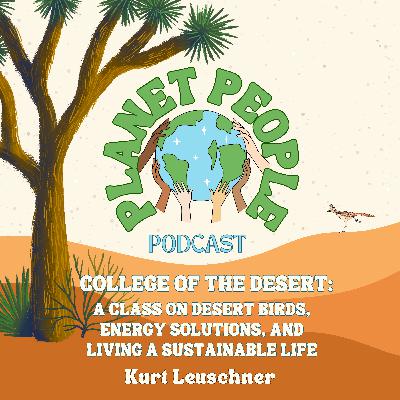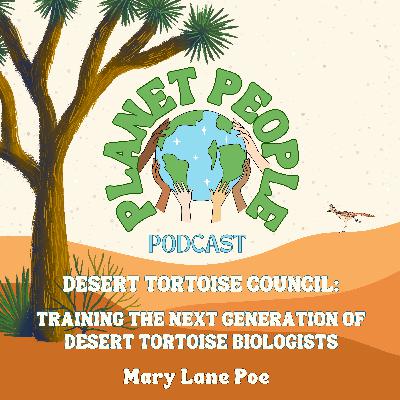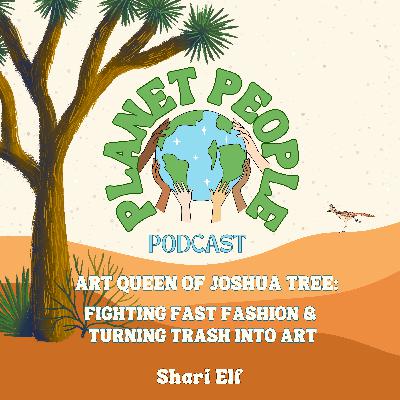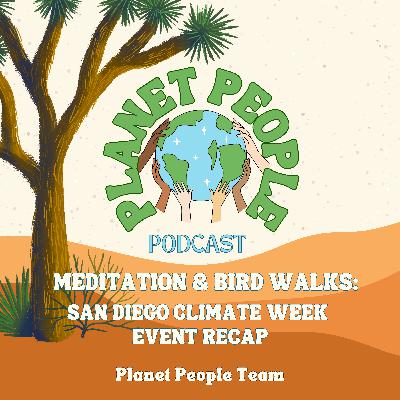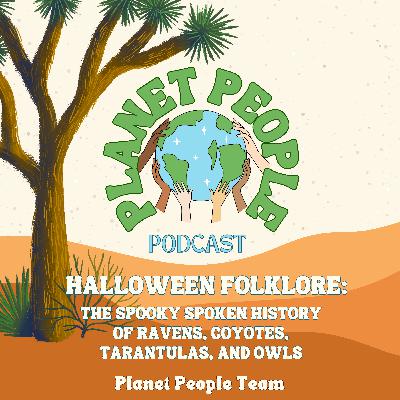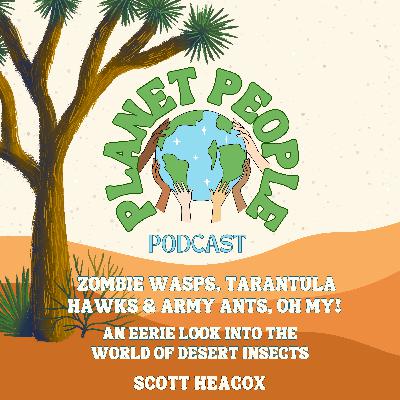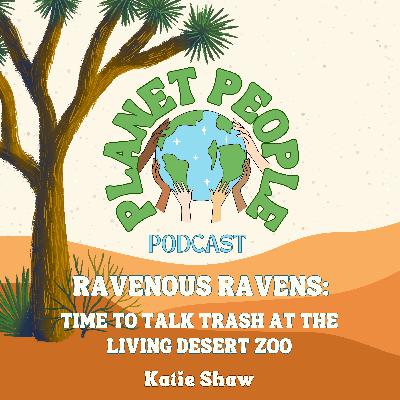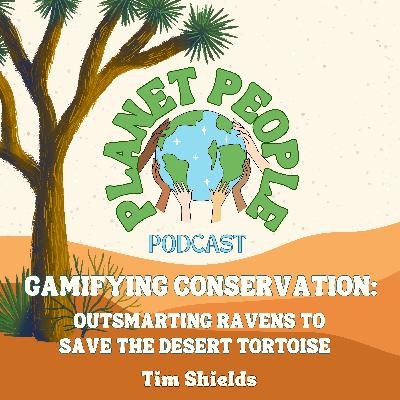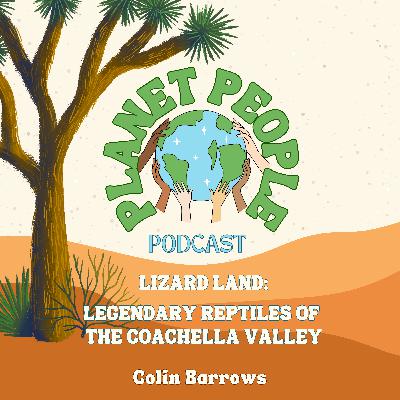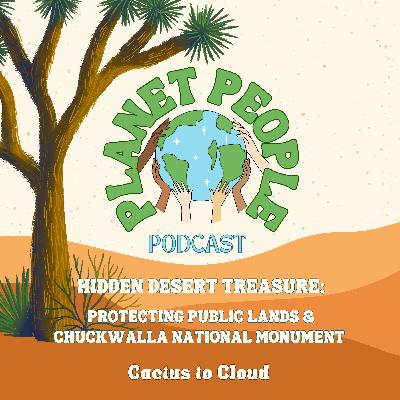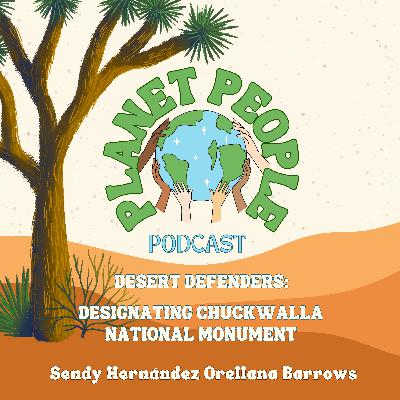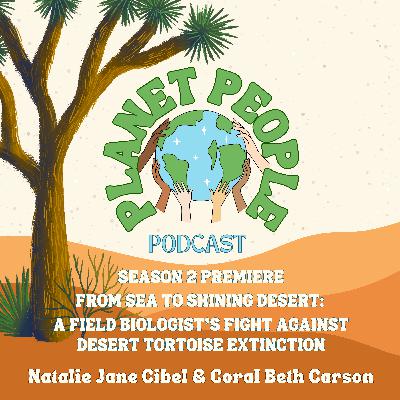Discover Planet People Podcast
Planet People Podcast

Planet People Podcast
Author: Planet People
Subscribed: 1Played: 21Subscribe
Share
Description
Welcome to Planet People, a podcast that aims to inspire curiosity and cultivate a deeper connection with the natural world. Hosted by Natalie Jane Cibel, a conservation biologist and eco communicator, and Coral Carson, Creative Director and artist. We are excited to share stories that highlight the beauty and importance of our planet's wildlife. The mission of the podcast is to strengthen and share stewardship stories through ethical storytelling.
39 Episodes
Reverse
In this festive discussion, hosts Coral and Natalie sit down with guest Jenli Kaylor to explore the art of sustainable holiday living through thrifting and upcycling. Together, they dive deep into creative ways to make the holiday season more environmentally conscious while still maintaining the magic and joy of the season. From transforming secondhand finds into meaningful gifts to reimagining holiday decorations with thrifted treasures, this conversation is packed with practical tips for anyone looking to reduce their environmental footprint during the most wonderful—and often most wasteful—time of year. Jenli shares her expertise on identifying quality pieces at thrift stores, creative upcycling techniques that turn forgotten items into holiday gold, and how to shift our mindset from consumption-focused celebrations to more intentional, sustainable practices. The discussion covers everything from DIY gift wrapping using repurposed materials to hosting eco-friendly holiday gatherings that don't compromise on style or sentiment. Join Coral, Jenli, and Natalie for this inspiring conversation that proves the holidays can be both magical and mindful! RAY OF HOPE: While the holiday season often brings anxiety about overconsumption and waste, there's a beautiful shift happening in how people approach gift-giving and celebrating. Thrift stores are seeing record numbers of creative shoppers who are discovering that the most meaningful gifts often come with stories—vintage books, restored furniture pieces, and unique finds that can't be bought new. Communities are embracing gift swaps, DIY workshops, and upcycling parties where neighbors gather to transform old items into new treasures. Social media is filled with inspiring before-and-after transformations that show how creativity can turn the discarded into the divine. The silver lining? Every thrifted gift is both an act of environmental stewardship and a more personal, thoughtful way to show love. You're not just reducing waste—you're giving something with character, history, and heart. ANXIETY TO ACTION: Start small this holiday season - Visit your local thrift store with a specific person or occasion in mind, and let yourself browse with creative eyes rather than a rigid shopping list. Build community around sustainable celebrating - Host a gift-wrapping party using newspapers, brown paper, and natural elements like pinecones and twigs. Organize a holiday decoration swap with neighbors to refresh your décor without having to buy new ones. CONNECT WITH JENLI: Follow @thejenliproject on Instagram and TikTok PLANET PEOPLE SOCIAL MEDIA: Follow Planet People on Instagram: @planet.people.pod Subscribe to us on YouTube: @PlanetPeoplePodcast
In this discussion, we interview Kurt Leuschner, a Professor of Natural Resources at the College of the Desert, a public community college serving the diverse Coachella Valley of Riverside County, California. College of the Desert enrolls approximately 12,500 students and is federally recognized as a Hispanic-serving institution, reflecting its commitment to educational accessibility in the region. Through his role at College of the Desert, Professor Leuschner is helping to educate the next generation of environmental stewards while contributing to our understanding of the remarkable biodiversity that calls the Coachella Valley home. In addition to our discussion on low-desert ecology, Kurt shares the many ways renewable energies are used across Southern California and how we can have hope for the progress humanity is making towards green energy solutions. Not only that, but he also shares the incredible efforts of rewilding desert landscapes by "killing your lawn" and planting native plants. Join us for this hopeful discussion around renewable energy, desert ecology, and what it means to rewild your desert landscape at home in your backyard! RAY OF HOPE: While climate news can feel overwhelming, there's a beautiful movement happening right under our noses. Across the country, people are transforming their lawns into native habitats, one yard at a time. These aren't grand gestures - they're quiet acts of rebellion against monoculture grass that's creating wildlife corridors through suburbia. Farmers are increasingly learning to spot burrowing owl nests, not because they're required to, but because they're discovering that protecting these tiny ecosystem engineers actually improves their soil health. Meanwhile, more people than ever are calling their representatives about environmental issues - democracy in action, one concerned citizen at a time. The silver lining? You don't need to save the whole planet today. You just need to plant one native shrub, make one phone call, or learn to identify one species in your area. These small acts are part of a growing web of environmental stewardship that's quietly rebuilding our connection to the natural world. ANXIETY TO ACTION: Begin with your backyard - Converting even a small patch to native plants creates immediate habitat and gives you a sense of agency. Build Community and share your native plant journey on social media to inspire neighbors. Join local environmental groups working on renewable energy advocacy. Connect with farmers in your area who are implementing wildlife-friendly practices. CONNECT WITH KURT: Email Kurt Lueshner: kleuschner@collegeofthedesert.edu PLANET PEOPLE SOCIAL MEDIA: Follow Planet People on Instagram: @planet.people.pod Subscribe to us on YouTube: @PlanetPeoplePodcast
Join us for an in-depth conversation about Mojave desert tortoise conservation efforts, from the original endangered species designation to current threats and protection strategies. In this interview with Mary Lane Poe of the Desert Tortoise Council, we review the many threats facing the desert tortoise, as well as meaningful ways for people to take action and even start a career in desert tortoise conservation. RAY OF HOPE: Here's something incredible: Desert tortoises are ancient ecosystem engineers that have survived ice ages, volcanic eruptions, and dramatic climate shifts over 15 million years. These slow-and-steady champions create burrows that become life-saving refuges for over 300 other desert species - from burrowing owls to kit foxes to countless invertebrates. They're living proof that resilience isn't about speed or aggression; it's about creating infrastructure that benefits entire communities. The Desert Tortoise Council represents something beautiful: people so inspired by these remarkable creatures that they've dedicated their lives to protecting them. Every time you engage with their social media, you're amplifying science-based conservation efforts that are working. The silver lining? Desert tortoises remind us that survival isn't just about individual resilience - it's about building systems that help everyone thrive. When you advocate for the places you love, you're following the tortoise model: creating lasting change through steady, persistent action. ANXIETY TO ACTION: You can turn your anxiety into action by volunteering with the Desert Tortoise Council, such as participating in the annual symposium event, serving on a committee, or becoming a board member. Additionally, it helps to interact with the Desert Tortoise Council Website social media, follow, like, comment, and share. It's also equally important to advocate for the places you love by writing official comment letters, calling your reps, and letting them know we need to keep these environmental policies in place. EPISODE RESOURCES: Sign up for the Desert Tortoise Introductory course here Annual symposium event information can be found here Health Assessment Training can be found here Learn more about habitat conservation with the Mojave Desert Land Trust FOLLOW MARY LANE POE AND THE DTC ON SOCIAL MEDIA: Follow Mary Lane Poe on Instagram Follow the Desert Tortoise Council on Instagram FOLLOW PLANET PEOPLE ON SOCIAL MEDIA: Follow Planet People on Instagram: @planet.people.pod Subscribe to us on YouTube: @PlanetPeoplePodcast
Join us as we explore the vibrant creative scene of Joshua Tree with Shari Elf, founder of Art Queen, whose innovative approach to upcycled fashion reveals the profound relationship between clothing, self-expression, and environmental consciousness. Shari shares what it means to transform discarded garments into wearable art, as well as the powerful story of how upcycling can serve as both a personal statement and a sustainable alternative to fast fashion's destructive cycle. In an era when the fashion industry is one of the world's largest polluters, this essential conversation challenges us to reassess our relationship with clothing and to recognize how reimagining and revitalizing garments can become a symbol of creativity, individuality, and environmental stewardship. RAY OF HOPE: In a time when fast fashion prevails and clothing waste fills our landfills, Shari's dedication to transforming discarded garments into unique pieces of wearable art stands as a powerful ray of hope, demonstrating that creativity and sustainability can merge to create something both beautiful and meaningful. This commitment to upcycling represents hope because it shows us a pathway forward: artists and makers reclaiming materials that would otherwise be waste and transforming them into expressions of identity, growing recognition that our clothing choices can be both personal statements and environmental actions, and a new generation learning to value craftsmanship, individuality, and the stories embedded in reimagined garments—ensuring that fashion becomes a force for positive change rather than environmental harm. ANXIETY TO ACTION: In an era when the fashion industry contributes massively to pollution and waste, and when social media often pressures us toward constant consumption of new trends, understanding the power of upcycled fashion reminds us that every garment tells a story, and that choosing to reimagine and revitalize clothing is both a creative act and a form of resistance against throwaway culture. Take Action: Learn basic clothing repair and alteration skills to extend the life of your garments. Support local artists and makers who create upcycled fashion. Shop secondhand and vintage before buying new. Organize clothing swaps in your community. Challenge fast fashion culture by embracing your personal style over fleeting trends. Share and celebrate creative upcycling projects to inspire others. SHARI SOCIAL MEDIA: Follow Shari on Instagram: @shari.elf World Famous Crochet Museum: @worldfamouscrochetmuseum Art Queen: @artqueen_jt PLANET PEOPLE SOCIAL MEDIA: Follow Planet People on Instagram: @planet.people.pod Subscribe to us on YouTube: @PlanetPeoplePodcast
Join us for a special shorter-format conversation as founder, Natalie, sits down with co-host and Creative Director, Coral Carson, to reflect on Planet People's remarkable 2.5-year journey. As we celebrate this milestone and enter our second season, we take a moment to express gratitude for our incredible community and discuss why Indigenous knowledge is foundational—not supplementary—to any meaningful conversation about conservation. This Thanksgiving episode sets the stage for our featured guest, Seth Bizardi Tsosie, a Native American monitor from the Lone Pine Paiute-Shoshone Tribe, whose insights about the Eastern Sierra Nevada will shift how you think about land, community, and our collective responsibility to the earth. Seth shares stories and knowledge that will shift how you think about land, community, and our collective responsibility to the earth. His insights offere powerful takeaways that everyone needs to hear, especially during this season of gratitude and reflection. Don't miss our previous episode (Episode 32) featuring Seth's full interview, where he dives deep into Indigenous knowledge of the Eastern Sierra Nevada and the untold story of the Owens Valley water grab. Listen to both episodes for the complete experience! RAY OF HOPE: In a world that often moves too fast to pause and reflect, the growth of the Planet People community over these 2.5 years stands as a powerful ray of hope, demonstrating that people still crave meaningful conversations about our relationship with nature and are eager to engage with ideas that honor both people and planet. This community's curiosity and commitment represent hope because it shows us a pathway forward: a growing movement of listeners who show up with care, a network of nature advocates and storytellers amplifying essential voices, and recognition that Indigenous perspectives are foundational to conservation work, ensuring that we build a more just and sustainable future together. ANXIETY TO ACTION: In an era when Indigenous voices have been historically marginalized in conservation conversations, recognizing that Indigenous knowledge is essential—not optional—reminds us that true environmental stewardship requires listening to and learning from the original stewards of the land whose wisdom about ecological balance and reciprocity spans thousands of years. Take Action: Engage with Indigenous-led conservation initiatives and organizations Educate yourself about Indigenous history and land rights in your region Support Indigenous-led environmental justice organizations, like @indigenouswomenhike, along with the advocacy movement to Protect Conglomerate Mesa. Support podcasts and platforms that center Indigenous voices and perspectives Share episodes like this one to help amplify Indigenous knowledge Practice gratitude not just during holidays, but by honoring the land and its original caretakers year-round Listen to Episode 32 with Seth Bizardi Tsosie for his complete story SOCIAL MEDIA: Follow Seth on Instagram: @indigenous.technology Follow Planet People on Instagram: @planet.people.pod Subscribe to us on YouTube: @PlanetPeoplePodcast
Join us as we explore the Eastern Sierra Nevada with Seth Bizardi Tsosie, a Native American monitor from the Lone Pine Paiute-Shoshone Tribe, whose ancestral knowledge reveals the profound relationship between Indigenous peoples and the land of flowing water. Seth shares what it means to grow up with generations of traditional ecological wisdom about this remarkable region, as well as the devastating story of how the Los Angeles Department of Water and Power systematically exploited and diverted the Owens Valley's lifeblood. As we approach Thanksgiving, this essential conversation challenges us to confront the true history of American land and water rights, and to understand the ongoing impacts of environmental injustice on indigenous communities whose connection to these waters spans millennia. RAY OF HOPE: In a time when Indigenous voices have been historically silenced and their lands exploited, Seth's willingness to share the Lone Pine Paiute-Shoshone Tribe's knowledge and perspective stands as a powerful ray of hope, demonstrating that Indigenous wisdom and resilience persist despite centuries of injustice. This dedication to preserving and sharing traditional knowledge represents hope because it shows us a pathway forward: Indigenous communities reclaiming their narratives and educating others about their connection to the land, growing recognition of the value of traditional ecological knowledge in addressing modern environmental challenges, and a new generation learning to honor and protect the relationship between people and water—ensuring that these stories and this wisdom continue to guide us toward more just and sustainable futures for all communities. ANXIETY TO ACTION: In an era when water rights battles continue and Indigenous communities still fight for recognition and justice, understanding the history of the Owens Valley water grab reminds us that the stories we tell during holidays like Thanksgiving matter, and that real American history includes reckoning with exploitation and learning from those whose knowledge of the land predates colonization. Take Action: Educate yourself about Indigenous history and land rights in your region. Support Indigenous-led environmental justice organizations, like @indigenouswomenhike, along with the advocacy movement to Protect Conglomerate Mesa. Be informed on the true history behind Thanksgiving and share accurate narratives. Advocate for Indigenous water rights and tribal sovereignty. Listen to and amplify Indigenous voices on environmental and conservation issues. SOCIAL MEDIA: Follow Seth on Instagram: @indigenous.technology Follow Planet People on Instagram: @planet.people.pod Subscribe to us on YouTube: @PlanetPeoplePodcast
Join us as we journey to the frozen continent of Antarctica with Dr. Steve Emslie, a leading Antarctic ecologist whose groundbreaking research on Adélie penguins has revealed fascinating insights into one of Earth's most extreme environments. From the remarkable adaptations of these charismatic seabirds to the surprising revelation that Antarctica is technically a desert, Dr. Emslie shares his discoveries from decades of fieldwork in the coldest, windiest, and driest place on our planet. This eye-opening conversation explores the delicate balance of polar ecosystems and why understanding Antarctica's past holds crucial insights for our planet's future. RAY OF HOPE: In a time when polar regions face unprecedented challenges from climate change, Dr. Steve Emslie's decades-long research on Adélie penguins and Antarctic ecology stands as a powerful ray of hope, demonstrating that through careful scientific study, we can understand and protect these remarkable ecosystems. This dedication to Antarctic science represents hope because it shows us a pathway forward: long-term ecological monitoring revealing how resilient these ecosystems can be, international scientific cooperation protecting the continent for peaceful research, and a deeper understanding of how Antarctic wildlife adapts to extreme conditions—knowledge that helps us predict and prepare for environmental changes affecting penguin colonies and polar biodiversity for generations to come. ANXIETY TO ACTION: In an era where Antarctic ice shelves are changing and penguin populations face new pressures, understanding the ecology of Adélie penguins and the unique desert environment of Antarctica reminds us that even the most remote ecosystems on Earth are connected to our daily choices and deserve our protection. Take Action: Learn about the Antarctic Treaty System and how international cooperation protects this unique continent Support organizations conducting polar research and conservation Reduce your carbon footprint to help protect polar regions from climate impacts Share the fascinating science of Antarctica to help others understand why polar ecosystems matter Follow Antarctic research stations and scientists on social media to stay connected with ongoing discoveries SOCIAL MEDIA: Follow us on Instagram: @planet.people.pod Subscribe to us on YouTube: @PlanetPeoplePodcast LISTEN TO "ALL ABOUT ANTARCTICA" Spotify Apple Podcasts PHOTO LINKS: Adélie Penguins Antarctic Landscape Antarctic Desert Facts Dr. Emslie's Research Guano
This episode takes you behind the scenes of our San Diego Climate Week event, where we combined mindfulness meditation with birdwatching to forge a deeper connection with the natural world and raise awareness about one of climate change's most vulnerable victims—our birds. Hosts Natalie and Coral share why they chose to lead a meditative bird walk during Climate Week, highlighting the critical relationship between climate change and declining bird populations. As habitats shift, migration patterns are disrupted, and food sources vanish, birds are serving as early warning indicators of our planet's changing health. Their songs and presence are not just beautiful—they're essential signals of a functioning ecosystem. We explore how meditation can transform our relationship with nature by slowing us down, sharpening our senses, and helping us truly observe the world around us. When we quiet our minds, we become better birdwatchers and more attuned listeners to what the planet is trying to tell us. This mindful approach to nature connection isn't just about appreciation—it's about understanding the urgent needs of our environment. The hosts discuss the experience of guiding participants through meditative practices before observing local bird species, and how this combination opened new pathways to environmental awareness. By cultivating presence and attention, we can better notice the changes happening in our backyards and communities—and feel more motivated to act. Ultimately, this episode delivers a sobering reminder: a world without birdsong is a world in trouble. When the birds fall silent, it's a warning we cannot ignore. Through meditation and mindful observation, we can deepen our connection to these vital creatures and become better stewards of the planet they—and we—call home. SOCIAL MEDIA: Follow us on Instagram: @planet.people.pod Subscribe to us on YouTube: @PlanetPeoplePodcast
It's Halloween on Planet People Podcast, and this episode dives into the eerie intersection of nature and folklore. Hosts Natalie and Coral are joined by their teammate Hugh Carr to explore the misunderstood realities of four creatures that have long haunted human imagination—the raven, coyote, tarantula, and owl. Hugh unpacks the mythological roots of ravens and coyotes as tricksters and spirit messengers. Additionally, he presents a fascinating theory regarding what may have contributed to ravens' dark portrayal throughout history and today… Natalie sheds light on the tarantula's misunderstood reputation, revealing why these gentle giants surface during October and how their real-life behavior inspired centuries of fear and folklore. Meanwhile, Coral delves into the owl's enduring mystique, from its silent flight and fixed gaze to the cultural symbolism that casts it as both a wise protector and an omen of death. Together, we unravel how myth and biology intertwine, proving that the creatures that spook us most often hold the deepest stories about the natural world. CREDITS: Spooky raven theory: @wingsandwildlands Raven, bear, wolf video: @wolfgirl_maine SOCIAL MEDIA: Follow us on Instagram: @planet.people.pod Subscribe to us on YouTube: @PlanetPeoplePodcast
Join us in continuing this Spooky Season as we sit down with Scott Heacox to explore the truly exciting world of parasitic insects in the Coachella Valley. From wasps that turn their hosts into living nurseries to fungi that create zombie ants, Scott reveals the fascinating and sometimes horrifying survival strategies of desert insects. This spine-tingling conversation uncovers the complex relationships between parasites and their hosts, demonstrating that the scariest stories aren't found in horror movies—they're happening right now in the desert ecosystem around us. RAY OF HOPE: In a time when insects are often misunderstood and feared, Scott Heacox's work stands as a powerful ray of hope, demonstrating that understanding these complex creatures—even the parasitic ones—reveals the intricate balance and resilience of desert ecosystems. This educational approach represents hope because it shows us a pathway forward: scientific curiosity replacing fear, local communities appreciating the ecological roles of all insects (even the creepy ones), and a deeper understanding of how parasitic relationships maintain healthy populations and biodiversity in the Coachella Valley for generations to come. ANXIETY TO ACTION: In an era where insect populations face unprecedented threats, understanding the fascinating world of parasitic wasps, ants, and crickets reminds us that every creature—no matter how unsettling—plays a vital role in maintaining the health of desert ecosystems. Take Action: Learn about the insects in your local desert ecosystem and their ecological roles Support desert conservation organizations protecting insect habitats Share your newfound knowledge about parasitic insects to help others overcome fear with understanding Participate in citizen science projects documenting desert insect populations SOCIAL MEDIA: Follow us on Instagram: @planet.people.pod Subscribe to us on YouTube: @PlanetPeoplePodcast PHOTO LINKS: Scorpion Photo & Video Parasitoid Wasp Orasema Heacoxi Death's Head Cockroach Bat Flies Water Strider
Join us as we sit down with Katie Shaw, a social scientist with The Living Desert Zoo in Palm Desert, to explore the fascinating intersection of human behavior and wildlife conservation. Kate shares insights into their innovative "Time to Talk Trash" conservation program, which targets the root cause of rising raven populations that threaten endangered desert tortoises. This eye-opening conversation reveals how changing human behavior around waste management can have profound impacts on desert ecosystems, demonstrating that sometimes the most effective wildlife conservation happens by focusing on people, not just animals. RAY OF HOPE: In a time when desert tortoise populations face mounting pressure from increasing raven predation, The Living Desert's "Time to Talk Trash" program stands as a powerful ray of hope, demonstrating that community conservation and social science can intersect to make a positive impact on imperiled desert wildlife. This community-driven approach represents hope because it shows us a pathway forward: social science informing conservation strategy, local communities becoming active partners in wildlife protection, and behavioral change programs that create lasting benefits for both people and the desert species that depend on balanced ecosystems for generations to come. ANXIETY TO ACTION: In an era where human activities increasingly impact wildlife survival, The Living Desert's trash management program reminds us that we have the power to be part of the solution, one behavioral change and one protected tortoise at a time. Take Action: Support The Living Desert's conservation programs and "Time to Talk Trash" initiative. Practice proper waste disposal and secure trash containers in desert communities. Educate others about the connection between human behavior and wildlife impacts. Advocate for community-based conservation programs that address root causes. RESOURCES: What are Ravenous Ravens? Learn more here. Learn more about The Living Desert and their conservation programs: here. "Time to Talk Trash" program information: here. Desert tortoise conservation resources: here. SOCIAL MEDIA: Follow on Instagram: @planet.people.pod Subscribe to us on YouTube: @PlanetPeoplePodcast
Get ready for our most innovative episode yet! In this episode, we explore the cutting-edge world of conservation technology (CTs) with Tim Shields from Ornilogic, who is revolutionizing desert tortoise protection through creative technological solutions. Tim shares mind-blowing conservation tools, including laser guns to deter raven presence and ingenious fake tortoise babies filled with grape juice designed to discourage ravens from eating real tortoise youngsters. This fascinating conversation explores how CTs are transforming wildlife protection by gamifying conservation efforts and making the fight against extinction both effective and FUN! RAY OF HOPE: In a time when traditional conservation methods struggle to keep pace with the rapid decline of species, Tim Shields' innovative CTs stand as a powerful ray of hope, demonstrating that creative problem-solving and cutting-edge tools can transform how we protect endangered species. By gamifying conservation through laser deterrents, decoy tortoises, and other ingenious devices, this approach shows that fighting extinction can be both scientifically rigorous and genuinely enjoyable for conservationists and the public alike. Tim's work represents hope because it shows us a pathway forward: technology making conservation more effective and engaging, creative solutions that outsmart wildlife threats, and innovative approaches that inspire the next generation of conservationists by proving that saving species can be as exciting as any video game. ANXIETY TO ACTION: In an era where extinction rates are accelerating, Tim Shields' conservation technologies remind us that we have the power to be part of the solution through innovation, creativity, and making conservation irresistibly engaging, one protected tortoise at a time. Take Action: Support Ornilogic and other conservation technology innovators. Advocate for funding conservation technology research and development. Share the excitement of conservation innovation to inspire others. Explore how technology and creativity can enhance local conservation efforts. RESOURCES: Learn more about Ornilogic and Tim Shields' CTs here. Tim Shields' TED Talk here. Desert tortoise protection programs here. Raven clicking noise - YouTube
Join us for an unforgettable conversation with Danielle Wall, recorded live at a studio in Joshua Tree, California! In this exclusive episode, Danielle shares wild stories from her years as a snake wrangler out West, fascinating fun facts about rattlesnake behavior, and essential rescue advice that could save both human and snake lives. The interview becomes even more exciting when Danielle brings out a baby rattlesnake, providing us with a rare up-close look at these remarkable desert predators. From dramatic rescue calls to the intricate world of snake biology, this episode will completely transform how you think about rattlesnakes and desert wildlife. RAY OF HOPE: In a time when fear and misunderstanding drive humans to kill harmless and beneficial snakes, Danielle Wall's mission to "save one snake and save one life" stands as a powerful ray of hope, demonstrating that compassion and education can transform our relationship with wildlife. Through her volunteer efforts in Joshua Tree, California, Danielle rescues and relocates rattlesnakes throughout the Mojave Desert, proving that coexistence is possible when we choose understanding over fear. Danielle's work represents hope because it shows us a pathway forward: changing hearts and minds one rescue at a time, building bridges between human communities and wildlife, and creating safer outcomes for both people and snakes through professional relocation services that benefit generations to come. ANXIETY TO ACTION: In an era where wildlife-human conflicts are increasing, Danielle's snake rescue work reminds us that we have the power to be part of the solution, one rescued rattlesnake at a time. Advocate for wildlife coexistence! Share educational content about snake safety and the important role snakes play in desert ecosystems. Call professional snake relocators instead of killing snakes - every life matters. RESOURCES: Follow Danielle Wall's snake rescue nonprofit: @high_desert_dani Snake safety and identification resources for the Mojave Desert: here PHOTO / VIDEO CREDIT: Northern Pacific | WildSafe B.C. Burrowing Owl Video Mojave Desert Photography | Colin Barrows Dani Photographers: Richard Stow: @richardstow Katie Shearer: @kateshearerstudio Shaughn and John: @shaughn_and_john
In this important episode, hosts Coral and Natalie discuss the history of Joshua tree conservation in Southern California and examine the groundbreaking Joshua Tree Conservation Act. They explore what it takes to protect these iconic desert trees under their own dedicated legislation, analyzing the current threats Joshua trees face from rapid solar development and the escalating impacts of climate change. This comprehensive conversation covers the legislative journey, conservation challenges, and the critical importance of specialized protection for one of the Mojave Desert's most beloved and vulnerable species. RAY OF HOPE: In a time when Joshua trees face unprecedented threats from development and climate change, the Joshua Tree Conservation Act stands as a powerful ray of hope, demonstrating that targeted legislation can provide specialized protection for vulnerable species. This dedicated act recognizes Joshua trees as unique and irreplaceable elements of Southern California's desert heritage, creating a framework for their long-term survival despite mounting environmental pressures. The Joshua Tree Conservation Act represents hope because it shows us a pathway forward: species-specific conservation legislation that addresses real threats, communities and lawmakers working together to protect iconic landscapes, and proactive measures that will safeguard these ancient desert sentinels for generations to come. ANXIETY TO ACTION: In an era of rapid desert development and climate uncertainty, the Joshua Tree Conservation Act reminds us that we have the power to be part of the solution, one protected tree and preserved habitat at a time. The iconic act is one of its kind, providing one single species with strong protections, paving the way for future species to be protected in their own right. Support the Joshua Tree Conservation Act by contacting your representatives. Advocate for responsible solar development that avoids critical Joshua tree habitat. Participate in public comment periods for desert development projects. Educate others about the unique ecological importance of Joshua trees. RESOURCES: Learn more about the Joshua Tree Conservation here Responsible renewable energy development guidelines here Climate change impacts on Joshua trees research here PHOTO CREDITS: Yucca Moth Yucca Moth | Ann Cooper Yucca Moth | NPS York Fire | David Swanson Dome Fire | JT Sohr, NPS Dome Fire | James Quigg Native Territories | SAND TO STONE Manirva Eastern Joshua Tree | Jim Boone Mojave Desert Photography | Colin Barrows
In this episode of Planet People, we are joined by Colin Barrows, a Coachella Valley naturalist, desert advocate, and Secretary of CactusToCloud Institute. Colin has extensive knowledge in desert ecology, particularly in reptiles and rare desert plants, and he shares many fascinating facts about lizard adaptations. We also uncover the secret life of lizards and what it takes for these creatures to survive in the rugged landscape of the low deserts of the Coachella Valley. CONNECT: Follow Colin Barrows on Instagram Follow @planet.people.pod for all the updates! RAY OF HOPE: In a time when habitat loss and climate change threaten reptile populations worldwide, the incredible lizard biodiversity of the Coachella Valley stands as a powerful ray of hope, demonstrating nature's remarkable resilience and adaptability. The newly designated Chuckwalla National Monument protects critical habitat for the iconic chuckwalla lizard and dozens of other reptile species, preserving 624,000 acres of irreplaceable desert ecosystem where these ancient creatures have thrived for millennia. Chuckwalla National Monument represents hope because it shows us that protecting biodiversity hotspots can safeguard entire ecosystems: preserving critical lizard habitat, maintaining desert food webs that countless species depend on, and ensuring that future generations will witness the spectacular diversity of desert reptiles that call the Coachella Valley home. ANXIETY TO ACTION: In an era of biodiversity loss and habitat fragmentation, the Chuckwalla Valley reminds us that we have the power to protect the remarkable creatures that share our planet, one preserved habitat at a time. Take Action: Interact with Cactus to Cloud social media - follow, like, comment, and share Advocate for the places and species you love! Write official comment letters, call your representatives, and let them know we need to keep these environmental protections in place Support local desert conservation efforts and reptile research initiatives RESOURCES: Learn more about Chuckwalla National Monument here. Acquire a California naturalist certification here. VOLUNTEER AND DONATE: Interested in helping with these conservation efforts? Subscribe to updates from Cactus to Cloud to learn how you can get involved. RELEVANT CONTENT: Listen to our previous episode with Colin and Sendy Barrows here PHOTO CREDITS: Mojave Desert Photography | Colin Barrows: https://cwbarrows.com/ Kangaroo Rat | Stan/stock.adobe.com: https://www.britannica.com/animal/kangaroo-rat Ironwood | Doris Evans: https://www.flickr.com/photos/dorisevans/27025026847/in/photostream/ Western Tanager | Bob Steventon: https://feederwatch.org/birdspotter-2019/western-tanager/ Cape May Warbler | Curtis A. Marantz: https://www.aba.org/southern-california-spring-2021/# Yucca Moth | NPS: https://www.nps.gov/museum/exhibits/jotr/Discovering-the-Desert/Diverse-Landscapes/Yucca-moth_NPS-detail.html Giant Ground Sloth | Encyclopædia Britannica, Inc.: https://www.britannica.com/animal/Megatherium
Several conservation, veteran, and recreation organizations have filed motions to intervene in a lawsuit defending the Chuckwalla National Monument designation. The monument, established in January 2025 on desert lands in California's Riverside and Imperial Counties, is being challenged by an Idaho-based motorized recreation group and a Michigan miner. The intervening organizations, including CactusToCloud Institute, spent years collaborating with Tribes, veterans, and community members to identify the area's unique tribal resources and values worthy of protection. Chuckwalla National Monument protects lands significant to 13 Tribal Nations while ensuring equitable access for outdoor recreation including camping, OHV use, and hunting. The designation has broad support from local Tribes, governments, elected officials, veterans, 300+ businesses, and 370+ scientists. RAY OF HOPE: Despite legal challenges, the coalition's intervention represents a unified front of diverse stakeholders committed to protecting Chuckwalla's irreplaceable desert landscapes, tribal heritage, and recreational opportunities. The broad-based support from local communities, Tribal Nations, veterans, scientists, and businesses demonstrates that conservation efforts built on genuine collaboration and community input create lasting, defendable protections. Organizations continue working to ensure equitable access while safeguarding the monument's ecological, cultural, and historical values for future generations. CONNECT: Follow our guests CactusToCloud Institute on Instagram: @cactustocloud Connect with other organizations defending the monument: Earthjustice: @earthjustice Sierra Club: @sierraclub Center for Biological Diversity: @centerforbiodiv RESOURCES: Protect Chuckwalla website - Learn more about community support Earthjustice Press Release - Full legal filing details CactusToCloud Institute - Local advocacy and education Bureau of Land Management - Monument management information CALL TO ACTION: Call Your Representatives! Contact your members of Congress to express support for Chuckwalla National Monument and the use of the Antiquities Act to protect important public lands. Let them know that monument designations have bipartisan support and benefit local economies, protect tribal heritage, and ensure recreational access for all Americans. Find your representatives: House: house.gov/representatives/find-your-representative Senate: senate.gov/senators/senators-contact.htm Sample message: "I support Chuckwalla National Monument and urge you to defend the president's authority under the Antiquities Act to protect our public lands for current and future generations."
In this episode of Planet People, co-hosts Natalie Jane Cibel and Coral Beth Carson sat down with Sendy Barrows, co-founder of the CactusToCloud Institute, to discuss the successful campaign that led to the designation of the Chuckwalla National Monument in January 2025. Barrows shares the behind-the-scenes story of how this conservation victory required years of dedicated advocacy work, bringing together diverse stakeholders in a comprehensive coalition-building effort. The new designation near Joshua Tree National Park protects wildlife and preserves Indigenous spiritual and cultural values tied to the land. Listeners will gain insight into the complex process of environmental advocacy and the persistence required to achieve lasting conservation outcomes. CONNECT: Follow Sendy Barrows on Instagram Follow @planet.people.pod for all the updates! RAY OF HOPE: In a time when climate change can feel overwhelming, the designation of Chuckwalla National Monument stands as a powerful ray of hope, demonstrating that grassroots community action can create meaningful climate solutions. By protecting these 624,000 acres of irreplaceable desert ecosystem, we're actively fighting climate change through land conservation. Chuckwalla National Monument represents hope because it shows us a pathway forward: local action creating lasting change, communities taking climate action into their own hands, and conservation efforts that will benefit generations to come. ANXIETY TO ACTION: In an era of climate anxiety, Chuckwalla reminds us that we have the power to be part of the solution, one protected landscape at a time. Interact with the Cactus to Cloud social media, follow, like, comment, and share. Follow them here. Advocate for the places you love! Write official comment letters, call your reps, and let them know we need to keep these environmental policies in place. RESOURCES: Learn more about Chuckwalla National Monument here. Acquire a California naturalist certification here. VOLUNTEER AND DONATE: Interested in helping with these conservation efforts? Subscribe to updates from Cactus to Cloud to learn how you can get involved. You can also support them by donating to this cause! RELEVANT CONTENT: Listen to our previous episode with All Creatures Podcast here
Join us for a casual and fun discussion with Natalie Jane Cibel, a conservation biologist and founder of Planet People, who has dedicated her career to studying and protecting one of the Mojave Desert's most iconic species: the desert tortoise. In this episode, Natalie takes us behind the scenes to see what it's really like to be a wildlife biologist working in the harsh but beautiful California desert, and shares incredible insights about the remarkable adaptations of these ancient reptiles. Natalie Jane is also the founder of Cibel Consulting and Communication Services. Her work focuses on understanding and protecting desert tortoise populations in the Mojave Desert of California, where she conducts field research and conservation efforts to ensure the survival of this threatened species. Through her field research, she also shares her journey as a conservationist and provides science communication through stories through Planet People. ANXIETY INTO ACTION: Find a mentor in the climate community to help guide your career in conservation. Go for a walk in the desert and embrace the solitude and find perspective on your connection the planet. EPISODE RESOURCES: Merlin Bird ID Tortoise of the World Textbook CONNECT WITH OUR GUEST: Instagram LinkedIn E-mail CONNECT WITH PLANET PEOPLE: Instagram LinkedIn E-mail
The desert is alive, and Season 2 of Planet People is here to prove it. Join founder and conservation biologist Natalie Jane Cibel, alongside newly joined co-host Coral Beth Carson, as we venture deeper into the Mojave Desert of Southern California and beyond, uncovering the hidden stories of life that thrive in one of Earth's most challenging environments. Our mission remains clear: to protect and celebrate the overlooked creatures that call these ancient landscapes home. From the elusive desert tortoise navigating climate change to the remarkable adaptations of sidewinder rattlesnakes and chuckwalla lizards, this season brings you face-to-face with the incredible animals that have mastered survival in the harshest conditions. Get ready for an unforgettable journey into the wild heart of the desert, where every bit of desert soil tells a story of resilience, adaptation, and the urgent need for conservation. Stay tuned for an exciting season 2 with desert conservation-themed episodes posted every other week and bonus episodes in between. This is a season you won't want to miss! We hope you enjoy our first intro episode, dropping next Wednesday with an exciting bonus episode to follow. Let us know in the comments what you think! Connect with Planet People: Follow @planet.people.pod on Instagram Follow @planet.people.pod on TikTok Follow @planet.people.pod on YouTube Follow @planet.people.pod on LinkedIn Follow Co-host @nat_uralistjane on Instagram and TikTok
Listen to this episode on your favorite podcast platform or watch the video version on our YouTube channel to see the birds we identify during our walk! Episode Overview This episode continues our conversation with park ranger Alex Wild, featuring a guided nature walk around San Elijo Lagoon. Alex identifies various birds and plants while discussing his role as a park ranger and sharing stories about inspiring environmental elders. This episode follows our previous discussion with Alex about recent attacks on National Parks and federal worker cuts that affected him personally. We had a special guest join us, Franklin the desert tortoise, Alex's former pet now serving as an animal ambassador at San Elijo. Keep reading to learn more about the birds we saw in this episode! Key Topics Discussed Major talking points included bird identification and birding tips, including creating a "life list" for birding. We also defined "Spark Birds" - the species that ignite someone's passion for birding and how ornithology lends itself to Alex's responsibilities as a park ranger. Spiritual connection to the land and the importance of role models as environmental elders who inspire. Most importantly, we discuss what it means to use our voice to protect natural spaces we love. Poetry Feature: "The Peace of Wild Things" By Wendell Berry When despair for the world grows in me and I wake in the night at the least sound in fear of what my life and my children's lives may be, I go and lie down where the wood drake rests in his beauty on the water, and the great heron feeds. I come into the peace of wild things who do not tax their lives with forethought of grief. I come into the presence of still water. And I feel above me the day-blind stars waiting with their light. For a time I rest in the grace of the world, and am free. Featured Segments Endangered Bird Segment: Endangered bird species are under threat! This recently published report from the 2025 US State of the Birds Report by the American Bird Conservancy outlines the threats that birds face across America and defines proactive solutions to protect bird populations for future generations. Key findings from the new report show that more than one-third of U.S. bird species are of high or moderate conservation concern, including 112 Tipping Point species that have lost more than 50 percent of their populations in the last 50 years. Betty Reid Soskin Park Ranger segment: Betty Reid Soskin (born Betty Charbonnet; 1921), now retired, was a park ranger with the National Park Service, assigned to the Rosie the Riveter/World War II Home Front National Historical Park in Richmond, California. In 2015, Betty was selected to participate in the national tree-lighting ceremony in President's Park at the White House, introducing President Barack Obama during the PBS telecast. At 100 years of age in 2022, Betty retired as the oldest park ranger in the National Park Service. Thank you for your hard-earned work, Betty! Related Content Protecting National Parks and Keeping Nature Wild w/ Alex Wild. Check out our earlier conversation with Alex about the challenges facing National Parks and federal workers. Hosts: Natalie Jane Cibel (@nat_uralistjane) and Coral Carson Birds Mentioned: Gnatcatcher (photo: Audubon & US Forest Service) Blue-gray Gnatcatcher (photo: Barbara-Houston) Gadwall Snowy Plover Coots Snowy Egret (Photo: Peter Prokosch & Mark Schocken) Grey Egret (Video: Lukas Pich) Double-crested Cormorant Least Tern Malachite Kingfisher (Videos: Anton Herrington, Matthew Williams-Ellis) African Spoonbill (Video: Day's Edge Productions) Marabou Stork (Video: Day's Edge Productions) Yellow-billed Stork (Video: Wind Collective) Saddle-billed Stork Wall Creeper Wall Creeper Reddit American Dipper (Photo NPS/Jared Hughey) American Dipper (Photo: Donald M. Jones and Lee Rentz) Black-backed Woodpecker Sapsucker (Photo: Grace Oliver) White-tailed Kite (Photo:Chris Conard) Mallard (Videos: Monster Filmmakers & Day's Edge Productions) Ridgeway's Rail (Photo: Ed Henry) Golden Eagle (Video:Wesley Aston) Elegant Tern (Photo: Willian Tyrer) Caspian Tern (Photo: Teal Baremore) Royal Tern (Photo: Owen Deutsch) Mullet Fish (Photo: Luvsd) Wrentit Bird (Photo: Scott Strei) Killdeer (Photo: Kira Henderson/Audubon Photography Awards) Robin (Yosemite) (Photo: Dennis Church) Anna's Hummingbird (Coastside Land Trust) Towhee (San Diego Bird Spot) Sparrows - San Diego Region (San Diego Bird Spot) Pied-billed Grebe (Photo: Jared Keyes) Eared Grebe (Photo: Matt Davis) Plants Mentioned: Sagebrush (My Home Park) Ponderosa Pine (Video: Amy Bornstein) Nasturtium (Botanical Interests) Arroyo Willow (Photo: Joan Avice) Wild Radish (Photo: Will Elder, NPS) Ragweed (Ambrosia) (Photo: Joanna Gilkeson/USFWS) Places Mentioned: Ramona Grasslands Preserve Sawtooth Canyon Yosemite Devil's Postpile People Mentioned: Alexander von Humboldt (Painting: Friedrich Georg Weitsch) Shelton Johnson (Photo: Cayce Clifford) Betty Reid Soskin (Photo: Luther Bailey) Apps Mentioned: E-bird Inaturalist Happy Whale Merlin Bird



